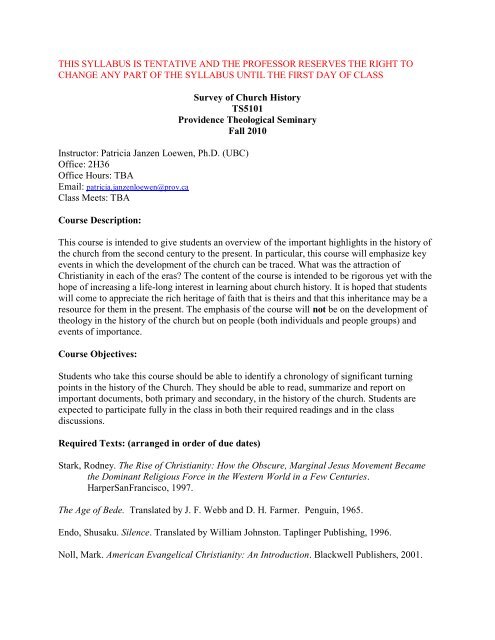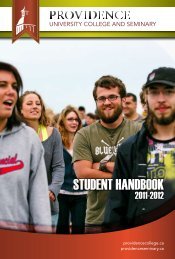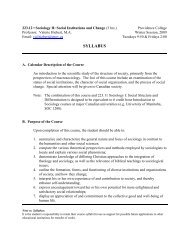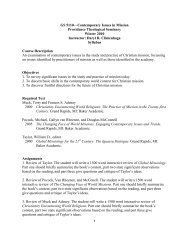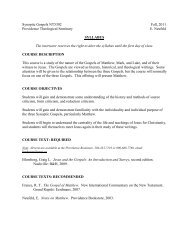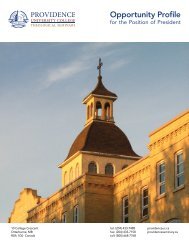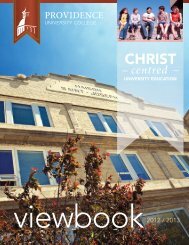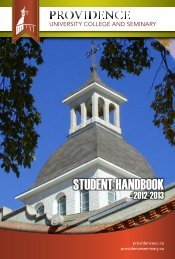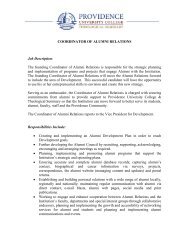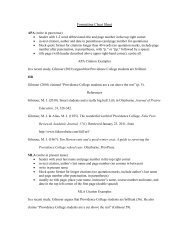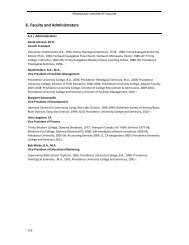this syllabus is tentative and the professor reserves the right to ...
this syllabus is tentative and the professor reserves the right to ...
this syllabus is tentative and the professor reserves the right to ...
Create successful ePaper yourself
Turn your PDF publications into a flip-book with our unique Google optimized e-Paper software.
THIS SYLLABUS IS TENTATIVE AND THE PROFESSOR RESERVES THE RIGHT TO<br />
CHANGE ANY PART OF THE SYLLABUS UNTIL THE FIRST DAY OF CLASS<br />
Survey of Church H<strong>is</strong><strong>to</strong>ry<br />
TS5101<br />
Providence Theological Seminary<br />
Fall 2010<br />
Instruc<strong>to</strong>r: Patricia Janzen Loewen, Ph.D. (UBC)<br />
Office: 2H36<br />
Office Hours: TBA<br />
Email: patricia.janzenloewen@prov.ca<br />
Class Meets: TBA<br />
Course Description:<br />
Th<strong>is</strong> course <strong>is</strong> intended <strong>to</strong> give students an overview of <strong>the</strong> important highlights in <strong>the</strong> h<strong>is</strong><strong>to</strong>ry of<br />
<strong>the</strong> church from <strong>the</strong> second century <strong>to</strong> <strong>the</strong> present. In particular, <strong>th<strong>is</strong></strong> course will emphasize key<br />
events in which <strong>the</strong> development of <strong>the</strong> church can be traced. What was <strong>the</strong> attraction of<br />
Chr<strong>is</strong>tianity in each of <strong>the</strong> eras? The content of <strong>the</strong> course <strong>is</strong> intended <strong>to</strong> be rigorous yet with <strong>the</strong><br />
hope of increasing a life-long interest in learning about church h<strong>is</strong><strong>to</strong>ry. It <strong>is</strong> hoped that students<br />
will come <strong>to</strong> appreciate <strong>the</strong> rich heritage of faith that <strong>is</strong> <strong>the</strong>irs <strong>and</strong> that <strong>th<strong>is</strong></strong> inheritance may be a<br />
resource for <strong>the</strong>m in <strong>the</strong> present. The emphas<strong>is</strong> of <strong>the</strong> course will not be on <strong>the</strong> development of<br />
<strong>the</strong>ology in <strong>the</strong> h<strong>is</strong><strong>to</strong>ry of <strong>the</strong> church but on people (both individuals <strong>and</strong> people groups) <strong>and</strong><br />
events of importance.<br />
Course Objectives:<br />
Students who take <strong>th<strong>is</strong></strong> course should be able <strong>to</strong> identify a chronology of significant turning<br />
points in <strong>the</strong> h<strong>is</strong><strong>to</strong>ry of <strong>the</strong> Church. They should be able <strong>to</strong> read, summarize <strong>and</strong> report on<br />
important documents, both primary <strong>and</strong> secondary, in <strong>the</strong> h<strong>is</strong><strong>to</strong>ry of <strong>the</strong> church. Students are<br />
expected <strong>to</strong> participate fully in <strong>the</strong> class in both <strong>the</strong>ir required readings <strong>and</strong> in <strong>the</strong> class<br />
d<strong>is</strong>cussions.<br />
Required Texts: (arranged in order of due dates)<br />
Stark, Rodney. The R<strong>is</strong>e of Chr<strong>is</strong>tianity: How <strong>the</strong> Obscure, Marginal Jesus Movement Became<br />
<strong>the</strong> Dominant Religious Force in <strong>the</strong> Western World in a Few Centuries.<br />
HarperSanFranc<strong>is</strong>co, 1997.<br />
The Age of Bede. Translated by J. F. Webb <strong>and</strong> D. H. Farmer. Penguin, 1965.<br />
Endo, Shusaku. Silence. Translated by William Johns<strong>to</strong>n. Taplinger Publ<strong>is</strong>hing, 1996.<br />
Noll, Mark. American Evangelical Chr<strong>is</strong>tianity: An Introduction. Blackwell Publ<strong>is</strong>hers, 2001.
Required Readings: (All <strong>the</strong>se readings will be available in Providence library—some will be<br />
available on reserve <strong>and</strong> may be pho<strong>to</strong>copied <strong>and</strong> o<strong>the</strong>rs will be available in <strong>the</strong> library’s bound<br />
periodicals or available for purchase in <strong>the</strong> books<strong>to</strong>re).<br />
D<strong>is</strong>cussion Paper 1<br />
The Passion of <strong>the</strong> Holy Martyrs Perpetua <strong>and</strong> Felicitas<br />
AND<br />
The Martyrdom of Polycarp<br />
D<strong>is</strong>cussion Paper 2<br />
“Franc<strong>is</strong> of Ass<strong>is</strong>i,” Chr<strong>is</strong>tian H<strong>is</strong><strong>to</strong>ry, Issue 42, pg 8-42.<br />
D<strong>is</strong>cussion Paper 3<br />
“African Apostles,” Chr<strong>is</strong>tian H<strong>is</strong><strong>to</strong>ry, Issue 79, pg. 10-44.<br />
D<strong>is</strong>cussion Paper 4<br />
Philip Jenkins, “The Next Chr<strong>is</strong>tianity,” Atlantic Monthly (Oc<strong>to</strong>ber 2002).<br />
Recommended Text:<br />
Harring<strong>to</strong>n, Joel. A Cloud of Witnesses: Readings in <strong>the</strong> H<strong>is</strong><strong>to</strong>ry of Western Chr<strong>is</strong>tianity.<br />
Hough<strong>to</strong>n Mifflin, 2001.<br />
Assignments:<br />
Book Reviews 4 x 15% each = 60% of <strong>to</strong>tal grade DUE: TBA<br />
Students will write four book reviews, one on each of <strong>the</strong> books by Stark, Cahill, Endo <strong>and</strong> Noll<br />
(as l<strong>is</strong>ted in <strong>the</strong> section above). Fur<strong>the</strong>r instructions are appended <strong>to</strong> <strong>th<strong>is</strong></strong> <strong>syllabus</strong>.<br />
D<strong>is</strong>cussion Papers 4 x 10% each = 40% of <strong>to</strong>tal grade DUE: TBA<br />
Students will submit four d<strong>is</strong>cussion papers, one on each of <strong>the</strong> d<strong>is</strong>cussion papers l<strong>is</strong>ted above.<br />
Students will be given a l<strong>is</strong>t of two or three questions <strong>to</strong> which <strong>the</strong>y must write <strong>and</strong> submit a<br />
d<strong>is</strong>cussion paper. Class time will be set aside for group d<strong>is</strong>cussion of <strong>the</strong> assigned readings. The<br />
d<strong>is</strong>cussion papers are intended <strong>to</strong> introduce <strong>the</strong> student <strong>to</strong> additional readings of interest <strong>and</strong><br />
prepare <strong>the</strong> student for in-class d<strong>is</strong>cussion on those readings. D<strong>is</strong>cussion papers must be<br />
2
submitted at <strong>the</strong> beginning of class on <strong>the</strong> due date <strong>and</strong> answer <strong>the</strong> assigned d<strong>is</strong>cussion<br />
questions. The d<strong>is</strong>cussion questions for each of <strong>the</strong> d<strong>is</strong>cussion papers will accompany <strong>the</strong><br />
<strong>syllabus</strong> given in <strong>the</strong> first class. All assignments must be h<strong>and</strong>ed in as hard copies—no electronic<br />
subm<strong>is</strong>sions will be accepted. Please bring hard copies of <strong>the</strong> assigned reading <strong>to</strong> <strong>the</strong> class on<br />
<strong>the</strong> day that <strong>the</strong> reading reports are due.<br />
Grading Scale:<br />
Course Policies:<br />
1. Class Attendance Policy<br />
Perfect attendance <strong>is</strong> expected of all students. Th<strong>is</strong> class has been designed <strong>to</strong> be highly<br />
interactive <strong>and</strong> every student’s participation <strong>is</strong> essential. If you cannot be in class, you should<br />
inform <strong>the</strong> <strong>professor</strong> before class of your anticipated absence (if possible). Attendance will be<br />
recorded for every class. Students who m<strong>is</strong>s more than <strong>the</strong> equivalent of 5 individual class<br />
slots will au<strong>to</strong>matically fail <strong>the</strong> course.<br />
2. Late Assignment Policies<br />
D<strong>is</strong>cussion Papers<br />
All d<strong>is</strong>cussion papers are due at <strong>the</strong> beginning of class on <strong>the</strong> designated due date. Any student<br />
who has not h<strong>and</strong>ed in h<strong>is</strong> or her d<strong>is</strong>cussion paper at <strong>the</strong> beginning of class will receive a zero for<br />
that assignment. There will be no exemption from penalty except in extreme circumstances.<br />
Book Reviews<br />
Book reviews submitted after <strong>the</strong> due date will be penalized one letter grade increment per day—<br />
including Saturdays <strong>and</strong> Sundays. For example, if <strong>the</strong> assignment <strong>is</strong> due on a Tuesday <strong>and</strong> <strong>is</strong><br />
submitted Wednesday <strong>the</strong> grade will drop one letter increment—for example from a “B+” <strong>to</strong> a<br />
“B.” If h<strong>and</strong>ed in on Thursday <strong>the</strong> mark for that assignment would drop two gradations—for<br />
example, from a “B+” <strong>to</strong> a “B-.” And so forth.<br />
All students w<strong>is</strong>hing <strong>to</strong> apply for exemption from <strong>the</strong> penalties given <strong>to</strong> late assignments must<br />
fill in <strong>and</strong> staple a hard copy of <strong>the</strong> “Late Assignment Subm<strong>is</strong>sion Form” (as attached <strong>to</strong> <strong>th<strong>is</strong></strong><br />
<strong>syllabus</strong>) <strong>to</strong> <strong>the</strong> assignment. Assignments h<strong>and</strong>ed in after <strong>the</strong> deadline which do not have <strong>th<strong>is</strong></strong><br />
form attached will not be considered for exemption from penalty.<br />
I will not personally accept any late assignments. All late subm<strong>is</strong>sions must be h<strong>and</strong>ed in <strong>to</strong> <strong>the</strong><br />
front office where <strong>the</strong>y will be date-stamped <strong>and</strong> put in<strong>to</strong> my mailbox by a staff member. Th<strong>is</strong><br />
means that an assignment must be h<strong>and</strong>ed in before <strong>the</strong> close of <strong>the</strong> front office <strong>to</strong> be considered<br />
h<strong>and</strong>ed in on that day.<br />
3
3. Plagiar<strong>is</strong>m<br />
Full text <strong>to</strong> <strong>the</strong> academic policies, procedures <strong>and</strong> regulations of Providence College can be<br />
found online in <strong>the</strong> Student H<strong>and</strong>book<br />
(http://www.providencecollege.ca/college/student_life/) <strong>and</strong> <strong>the</strong> College Academic Calendar<br />
(http://www.providencecollege.ca/college/programs/reg<strong>is</strong>trars_office/calendar/).<br />
4. Information <strong>and</strong> Communication Technologies in <strong>the</strong> Classroom<br />
Student use of information <strong>and</strong> communication technologies for purposes o<strong>the</strong>r than class notetaking<br />
<strong>is</strong> not allowed in <strong>the</strong> classroom, as students are expected <strong>to</strong> give <strong>the</strong>ir <strong>to</strong>tal attention <strong>to</strong><br />
class activities. Use of cell-phones or iPods <strong>is</strong> never appropriate in <strong>the</strong> classroom, <strong>and</strong> use of<br />
lap<strong>to</strong>p computers <strong>to</strong> play games, chat with o<strong>the</strong>rs, browse <strong>the</strong> internet, or engage material not<br />
related <strong>to</strong> <strong>the</strong> class <strong>is</strong> always d<strong>is</strong>tracting <strong>to</strong> classmates <strong>and</strong> d<strong>is</strong>respectful <strong>to</strong> <strong>the</strong> instruc<strong>to</strong>r. Unlike<br />
some o<strong>the</strong>r post-secondary institutions, Providence has not yet found it necessary <strong>to</strong> ban lap<strong>to</strong>ps<br />
from <strong>the</strong> classroom, or prevent wireless internet access in classrooms. Only judicious use of <strong>the</strong>m<br />
will keep it that way.<br />
Course Schedule:<br />
(Th<strong>is</strong> schedule <strong>is</strong> from Fall 2010—given as a sample)<br />
Sept. 10<br />
Sept. 14<br />
Sept. 17<br />
Sept. 21<br />
Sept. 24<br />
Sept. 28<br />
Oct. 1<br />
Oct. 5<br />
Oct. 19<br />
Oct. 22<br />
Oct. 26<br />
Oct. 29<br />
Syllabus <strong>and</strong> Introductions<br />
The Early Church—The Context of <strong>the</strong> Roman Empire<br />
The Early Church—The Experience of Martyrdom<br />
DUE: D<strong>is</strong>cussion Paper—Polycarp <strong>and</strong> Perpetua<br />
Constantine <strong>and</strong> <strong>the</strong> Great Reversal of <strong>the</strong> Fourth Century<br />
DUE: Book Review—The R<strong>is</strong>e of Chr<strong>is</strong>tianity by Stark<br />
Early Middle Ages<br />
Middle Ages<br />
DUE: Book Review—How <strong>the</strong> Ir<strong>is</strong>h Saved Civilization by Cahill<br />
Middle Ages<br />
Eastern Orthodoxy<br />
Late Middle Ages<br />
DUE: D<strong>is</strong>cussion Paper—Franc<strong>is</strong> of Ass<strong>is</strong>i<br />
Reformation—Lu<strong>the</strong>r <strong>and</strong> Calvin<br />
4
Nov. 2<br />
Nov. 5<br />
Nov. 9<br />
Nov. 12<br />
Reformation—Zwingli <strong>and</strong> Anabapt<strong>is</strong>ts<br />
Reformation—Engl<strong>and</strong> <strong>and</strong> France<br />
Reformation—Catholic<br />
DUE: Book Review—Silence by Endo<br />
Nov. 23 Chr<strong>is</strong>tianity 1600-1800<br />
Nov. 26 Chr<strong>is</strong>tianity 1600-1800<br />
Nov. 30<br />
Dec. 3<br />
Dec. 7<br />
Dec. 10<br />
Dec. 14<br />
Dec. 17<br />
Chr<strong>is</strong>tianity 1800-1900 as Global M<strong>is</strong>sion<br />
DUE: D<strong>is</strong>cussion Paper—African Apostles<br />
Chr<strong>is</strong>tianity 1800-1900 as Social Reform<br />
Chr<strong>is</strong>tianity 1900-2000 in America<br />
DUE: Book Review—The Sc<strong>and</strong>al of <strong>the</strong> Evangelical Mind by Noll<br />
Chr<strong>is</strong>tianity 1900-2000 in Europe<br />
Chr<strong>is</strong>tianity 1900-2000 in a Global Context<br />
DUE: D<strong>is</strong>cussion Paper—“The Next Chr<strong>is</strong>tianity” by Jenkins<br />
NOTE: The course schedule <strong>is</strong> subject <strong>to</strong> change<br />
Bibliography:<br />
Balling, Jakob. The S<strong>to</strong>ry of Chr<strong>is</strong>tianity from Birth <strong>to</strong> Global Presence. Gr<strong>and</strong> Rapids, MI:<br />
William B. Eerdmans, 2003.<br />
Bradley, James E <strong>and</strong> Richard A. Muller. Church H<strong>is</strong><strong>to</strong>ry: An Introduction <strong>to</strong> Research,<br />
Reference Works, <strong>and</strong> Methods. Gr<strong>and</strong> Rapids, MI: William B. Eerdmans, 1995.<br />
Bynum, Caroline Walker. Holy Feast, Holy Fast: The Religious Significance of Food <strong>to</strong><br />
Medieval Women. Berkeley, CA: University of California, 1987.<br />
Chadwick, Henry. The Early Church. New York: Penguin, 1990.<br />
Chadwick, Owen. The Reformation. New York: Penguin, 1990.<br />
Clark, Gillian. Chr<strong>is</strong>tianity <strong>and</strong> Roman Society. Cambridge: Cambridge University, 2004.<br />
Cragg, Gerald. The Age of Reason, 1648-1989. New York: Penguin, 1990.<br />
5
Dowley, Tim, ed. Introduction <strong>to</strong> <strong>the</strong> H<strong>is</strong><strong>to</strong>ry of Chr<strong>is</strong>tianity. Minneapol<strong>is</strong>, MN: Fortress,<br />
1995.<br />
González, Jus<strong>to</strong> L. The S<strong>to</strong>ry of Chr<strong>is</strong>tianity: The Early Church <strong>to</strong> <strong>the</strong> Dawn of <strong>the</strong><br />
Reformation. Vol. 1. New York: HarperSanFranc<strong>is</strong>co, 1984.<br />
________. The S<strong>to</strong>ry of Chr<strong>is</strong>tianity: The Reformation <strong>to</strong> <strong>the</strong> Present Day. Vol. 2.<br />
New York: HarperSanFranc<strong>is</strong>co, 1985.<br />
Hastings, Adrian, ed. A World H<strong>is</strong><strong>to</strong>ry of Chr<strong>is</strong>tianity. Gr<strong>and</strong> Rapids, MI: William B.<br />
Eerdmans, 2000.<br />
Neill, Stephen. A H<strong>is</strong><strong>to</strong>ry of Chr<strong>is</strong>tian M<strong>is</strong>sion. New York: Penguin, 1990.<br />
Noll, Mark A. A H<strong>is</strong><strong>to</strong>ry of Chr<strong>is</strong>tianity in <strong>the</strong> United States <strong>and</strong> Canada. Gr<strong>and</strong> Rapids, MI:<br />
William B. Eerdmans, 1992.<br />
Noll, Mark A. Turning Points: Dec<strong>is</strong>ive Moments in <strong>the</strong> H<strong>is</strong><strong>to</strong>ry of Chr<strong>is</strong>tianity. Gr<strong>and</strong><br />
Rapids, MI: Baker Academic, 1997.<br />
Peterson, R. Dean. A Conc<strong>is</strong>e H<strong>is</strong><strong>to</strong>ry of Chr<strong>is</strong>tianity. Belmont, CA: Wadsworth, 1999.<br />
Sou<strong>the</strong>rn, R. W. The Middle Ages. New York: Penguin, 1990.<br />
Vidler, Alec R. The Church in an Age of Revolution. New York: Penguin, 1990.<br />
Wilken, Robert Lou<strong>is</strong>. The Spirit of Early Chr<strong>is</strong>tian Thought: Seeking <strong>the</strong> Face of God. New<br />
Haven, CT: Yale University, 2003.<br />
6
Book Report --Evaluation<br />
(Th<strong>is</strong> evaluation sheet will be used as <strong>the</strong> grade guide for all <strong>the</strong> book reports except Silence)<br />
Student’s Name_________________________________________________<br />
Note: Circled check mark means “excellent”; check mark means “good”; horizontal line means<br />
“something was done”; blank means “nothing evident” or “not applicable.”<br />
I.______ Explanation of title attempted<br />
_____ Clear statement of subject <strong>and</strong> related <strong>to</strong> title<br />
_____ Clear statement of purpose <strong>and</strong> related <strong>to</strong> title<br />
_____ Clear statement of <strong>the</strong>s<strong>is</strong> <strong>and</strong> related <strong>to</strong> title<br />
II._____ D<strong>is</strong>cussion of argument/structure<br />
_____ Adequate d<strong>is</strong>cussion of each section<br />
_____ Clear outline of report<br />
_____ Structure of book clearly shown<br />
_____ D<strong>is</strong>cussion problematic in <strong>the</strong> following:________________________<br />
_______________________________________________________________<br />
III.____ Evaluation attempted<br />
_____ Unusually insightful <strong>and</strong> thorough evaluation<br />
_____ Thoughtful, substantial reflection evident<br />
_____ Some worthy thought, but <strong>to</strong>o brief or o<strong>the</strong>rw<strong>is</strong>e flawed______________<br />
_____ Does not show careful thought<br />
IV.____ Personal impressions given<br />
_____ Positive personal reflections<br />
_____ Negative personal reflections<br />
V._____ Writing<br />
_____ Excellently written<br />
_____ Clearly written for <strong>the</strong> most part<br />
_____ Serious problems with organization, flow of argument, etc.<br />
_____ Serious problems with grammar, spelling, etc.<br />
VI.____ O<strong>the</strong>r Requirements<br />
_____ Correct word length<br />
_____ Too short<br />
_____ Too long<br />
_____ Generally follows correct style<br />
_____ Several problems with style<br />
_____ Major departures from style<br />
_____ Generally unacceptable presentation<br />
VII._____ M<strong>is</strong>cellaneous<br />
_____ Type <strong>is</strong> hard <strong>to</strong> read<br />
_____ Pages not numbered<br />
7
Book Report—Content<br />
The objectives of <strong>the</strong> book report are first <strong>to</strong> allow students an opportunity <strong>to</strong> engage serious<br />
reading from <strong>the</strong> h<strong>is</strong><strong>to</strong>ry of Chr<strong>is</strong>tianity. Second, <strong>the</strong> book report provides students an opportunity <strong>to</strong><br />
demonstrate <strong>the</strong>ir ability <strong>to</strong> summarize <strong>and</strong> syn<strong>the</strong>size a text <strong>and</strong> express that process in prec<strong>is</strong>e writing.<br />
Requirements:<br />
1. Word Count<br />
Reports must be between 2000-2500 words. Subm<strong>is</strong>sions which are <strong>to</strong>o long or <strong>to</strong>o short will be<br />
penalized.<br />
2. Style Guide<br />
Reports must conform <strong>to</strong> a st<strong>and</strong>ard style guide (such as Chicago Manual of Style/Turabian). If<br />
you are unsure about your choice of style guide, please consult me.<br />
3. Content—Reports must respond <strong>to</strong> <strong>the</strong> following:<br />
4. Title Page<br />
Explain <strong>the</strong> title—in terms of <strong>the</strong> subject, purpose <strong>and</strong> <strong>the</strong>s<strong>is</strong> of <strong>the</strong> work<br />
Set out <strong>the</strong> basic structure of <strong>the</strong> book—show how <strong>the</strong> parts of <strong>the</strong> work fit <strong>to</strong>ge<strong>the</strong>r<br />
in<strong>to</strong> a whole. Th<strong>is</strong> part should take about 30-40% of <strong>the</strong> report.<br />
Evaluate <strong>the</strong> book—how well do you think <strong>the</strong> author achieved h<strong>is</strong> goals? Th<strong>is</strong> part<br />
should take about 20-30% of <strong>the</strong> report.<br />
Impressions—what are two things that impressed you positively? What are two things<br />
that impressed you negatively? Your impressions should be personal <strong>and</strong> specific.<br />
You should use <strong>the</strong> first person when you write <strong>th<strong>is</strong></strong> section.<br />
All assignments must have a title page which includes <strong>the</strong> name of <strong>the</strong> assignment, date, <strong>the</strong><br />
student’s name, box number, <strong>and</strong> student number, <strong>the</strong> <strong>professor</strong>’s name <strong>and</strong> name of <strong>the</strong> course.<br />
8
Book Report –Evaluation of Silence<br />
Student’s Name_________________________________________________<br />
Note: Circled check mark means “excellent”; check mark means “good”; horizontal line means<br />
“something was done”; blank means “nothing evident” or “not applicable.”<br />
I._____ Summary of Book (What happens? Can you sketch <strong>the</strong> s<strong>to</strong>ry of <strong>the</strong> book?)<br />
_____ Adequate d<strong>is</strong>cussion of each section<br />
_____ Clear outline of book<br />
_____ D<strong>is</strong>cussion problematic in <strong>the</strong> following way:__________________________<br />
_______________________________________________________________<br />
II._____ Identify Themes<br />
______ Identification of important <strong>the</strong>mes<br />
______ Explanation of <strong>the</strong>me development<br />
III.____ Evaluation attempted<br />
_____ Unusually insightful <strong>and</strong> thorough evaluation<br />
_____ Thoughtful, substantial reflection evident<br />
_____ Some worthy thought, but <strong>to</strong>o brief or o<strong>the</strong>rw<strong>is</strong>e flawed______________<br />
_____ Does not show careful thought<br />
IV.____ Personal impressions given<br />
_____ Positive personal reflections<br />
_____ Negative personal reflections<br />
V._____ Writing<br />
_____ Excellently written<br />
_____ Clearly written for <strong>the</strong> most part<br />
_____ Serious problems with organization, flow of argument, etc.<br />
_____ Serious problems with grammar, spelling, etc.<br />
VI.____ O<strong>the</strong>r Requirements<br />
_____ Correct word length<br />
_____ Too short<br />
_____ Too long<br />
_____ Generally follows correct style<br />
_____ Several problems with style<br />
_____ Major departures from style<br />
_____ Generally unacceptable presentation<br />
VII._____ M<strong>is</strong>cellaneous<br />
_____ Type <strong>is</strong> hard <strong>to</strong> read<br />
_____ Pages not numbered<br />
9
Book Report—Content of Silence<br />
The objectives of <strong>the</strong> book report are first <strong>to</strong> allow students an opportunity <strong>to</strong> engage serious<br />
reading from <strong>the</strong> h<strong>is</strong><strong>to</strong>ry of Chr<strong>is</strong>tianity. Second, <strong>the</strong> book report provides students an opportunity <strong>to</strong><br />
demonstrate <strong>the</strong>ir ability <strong>to</strong> summarize <strong>and</strong> syn<strong>the</strong>size a text <strong>and</strong> express that process in prec<strong>is</strong>e writing.<br />
Requirements:<br />
1. Word Count<br />
Reports must be between 2000-2500 words. Subm<strong>is</strong>sions which are <strong>to</strong>o long or <strong>to</strong>o short will be<br />
penalized.<br />
2. Style Guide<br />
Reports must conform <strong>to</strong> a st<strong>and</strong>ard style guide (such as Chicago Manual of Style/Turabian). If<br />
you are unsure about your choice of style guide, please consult me.<br />
3. Content—Reports must respond <strong>to</strong> <strong>the</strong> following:<br />
4. Title Page<br />
Set out <strong>the</strong> basic structure of <strong>the</strong> book—show how <strong>the</strong> parts of <strong>the</strong> work fit <strong>to</strong>ge<strong>the</strong>r<br />
in<strong>to</strong> a whole. Th<strong>is</strong> part should take about 30-40% of <strong>the</strong> report.<br />
Identify Themes—identify <strong>the</strong> most important <strong>the</strong>mes <strong>to</strong> emerge in <strong>the</strong> s<strong>to</strong>ry <strong>and</strong> explain<br />
how <strong>the</strong>se <strong>the</strong>mes are developed. Th<strong>is</strong> should be about 20-30% of <strong>the</strong> report.<br />
Evaluate <strong>the</strong> book—how well do you think <strong>the</strong> author achieved h<strong>is</strong> goals? Th<strong>is</strong> part<br />
should take about 10-20% of <strong>the</strong> report.<br />
Impressions—what are two things that impressed you positively? What are two things<br />
that impressed you negatively? Your impressions should be personal <strong>and</strong> specific.<br />
You should use <strong>the</strong> first person when you write <strong>th<strong>is</strong></strong> section.<br />
All assignments must have a title page which includes <strong>the</strong> name of <strong>the</strong> assignment, date, <strong>the</strong> student’s<br />
name, box number, <strong>and</strong> student number, <strong>the</strong> <strong>professor</strong>’s name <strong>and</strong> name of <strong>the</strong> course.<br />
10
D<strong>is</strong>cussion Questions for Polycarp <strong>and</strong> Perpetua<br />
1. Provide a brief summary of <strong>the</strong>se two accounts of martyrdom. What particularly impressed<br />
you about <strong>the</strong>se accounts?<br />
2. Speculate as <strong>to</strong> why <strong>the</strong> Chr<strong>is</strong>tian community would think that <strong>the</strong> actions of <strong>the</strong> martyrs were<br />
not only acceptable but good?<br />
3. What do you think someone watching <strong>the</strong>se martyrs would have thought? In your opinion, in<br />
what ways were <strong>the</strong>se martyrs effective (or perhaps ineffective) witnesses <strong>to</strong> <strong>the</strong>ir faith?<br />
D<strong>is</strong>cussion papers must adhere <strong>to</strong> <strong>the</strong> following style:<br />
Typed<br />
Double-spaced<br />
Single-sided<br />
1-inch margins on all sides<br />
12-point font<br />
Pages numbered<br />
Fastened with a staple or paper clip<br />
Use full sentences <strong>and</strong> paragraphs (no point-form allowed)<br />
Have a title page (including student’s name, student number, box number, date, course<br />
name <strong>and</strong> assignment name)<br />
D<strong>is</strong>cussion papers must be between 750-1000 words. Papers which are shorter or longer than<br />
<strong>th<strong>is</strong></strong> word count will be penalized.<br />
NOTE: Full citation of <strong>the</strong> text <strong>is</strong> not required, however you must put <strong>the</strong> page number(s) of any<br />
material quoted from <strong>the</strong> reading in brackets at <strong>the</strong> end of <strong>the</strong> quote.<br />
11
D<strong>is</strong>cussion Questions for St. Franc<strong>is</strong> of Ass<strong>is</strong>i<br />
1. After reading <strong>the</strong>se various articles, summarize <strong>the</strong> life of St. Franc<strong>is</strong>. Also summarize <strong>the</strong><br />
character of St. Franc<strong>is</strong>. Do you think you would have liked him?<br />
2. Compare <strong>the</strong> monastic<strong>is</strong>m of St. Franc<strong>is</strong> with monastic<strong>is</strong>m that came before it—such as <strong>the</strong><br />
early desert monks <strong>and</strong> <strong>the</strong> Benedictine monks. What <strong>is</strong> <strong>the</strong> same <strong>and</strong> what <strong>is</strong> different? Why<br />
would St. Franc<strong>is</strong> <strong>and</strong> h<strong>is</strong> kind of monastic<strong>is</strong>m been attractive in <strong>the</strong> Late Middle Ages?<br />
3. What, if anything, can be learned from <strong>the</strong> life <strong>and</strong> piety of St. Franc<strong>is</strong> in <strong>to</strong>day’s church?<br />
D<strong>is</strong>cussion papers must adhere <strong>to</strong> <strong>the</strong> following style:<br />
Typed<br />
Double-spaced<br />
Single-sided<br />
1-inch margins on all sides<br />
12-point font<br />
Pages numbered<br />
Fastened with a staple or paper clip<br />
Use full sentences <strong>and</strong> paragraphs (no point-form allowed)<br />
Have a title page (including student’s name, student number, box number, date, course<br />
name <strong>and</strong> assignment name)<br />
D<strong>is</strong>cussion papers must be between 750-1000 words. Papers which are shorter or longer than<br />
<strong>th<strong>is</strong></strong> word count will be penalized.<br />
NOTE: Full citation of <strong>the</strong> text <strong>is</strong> not required, however you must put <strong>the</strong> page number(s) of any<br />
material quoted from <strong>the</strong> reading in brackets at <strong>the</strong> end of <strong>the</strong> quote.<br />
12
D<strong>is</strong>cussion Questions for African Apostles<br />
1. Briefly summarize <strong>the</strong> life <strong>and</strong> work of <strong>the</strong> various individuals d<strong>is</strong>cussed in <strong>the</strong>se pages.<br />
2. How <strong>is</strong> <strong>the</strong> h<strong>is</strong><strong>to</strong>ry of Chr<strong>is</strong>tianity in Africa of <strong>th<strong>is</strong></strong> era like what we have learned so far? How<br />
<strong>is</strong> it different?<br />
3. What about Chr<strong>is</strong>tianity was attractive in <strong>the</strong> African context at <strong>th<strong>is</strong></strong> time?<br />
D<strong>is</strong>cussion papers must adhere <strong>to</strong> <strong>the</strong> following style:<br />
Typed<br />
Double-spaced<br />
Single-sided<br />
1-inch margins on all sides<br />
12-point font<br />
Pages numbered<br />
Fastened with a staple or paper clip<br />
Use full sentences <strong>and</strong> paragraphs (no point-form allowed)<br />
Have a title page (including student’s name, student number, box number, date, course<br />
name <strong>and</strong> assignment name)<br />
D<strong>is</strong>cussion papers must be between 750-1000 words. Papers which are shorter or longer than<br />
<strong>th<strong>is</strong></strong> word count will be penalized.<br />
NOTE: Full citation of <strong>the</strong> text <strong>is</strong> not required, however you must put <strong>the</strong> page number(s) of any<br />
material quoted from <strong>the</strong> reading in brackets at <strong>the</strong> end of <strong>the</strong> quote.<br />
13
D<strong>is</strong>cussion Questions for “The Next Chr<strong>is</strong>tianity” by Jenkins<br />
1. Briefly summarize Jenkins’s article. Do you agree or d<strong>is</strong>agree with h<strong>is</strong> basic <strong>the</strong>s<strong>is</strong>? Why or<br />
why not?<br />
2. What <strong>is</strong> attractive about Chr<strong>is</strong>tianity in <strong>the</strong> twenty-first century?<br />
3. Speculate about <strong>the</strong> future. What will Chr<strong>is</strong>tianity look like in a century? How will it be <strong>the</strong><br />
same as or different from Chr<strong>is</strong>tianity at present? What <strong>is</strong> <strong>the</strong> greatest challenge that twentyfirst-century<br />
Chr<strong>is</strong>tians must address?<br />
D<strong>is</strong>cussion papers must adhere <strong>to</strong> <strong>the</strong> following style:<br />
Typed<br />
Double-spaced<br />
Single-sided<br />
1-inch margins on all sides<br />
12-point font<br />
Pages numbered<br />
Fastened with a staple or paper clip<br />
Use full sentences <strong>and</strong> paragraphs (no point-form allowed)<br />
Have a title page (including student’s name, student number, box number, date, course<br />
name <strong>and</strong> assignment name)<br />
D<strong>is</strong>cussion papers must be between 750-1000 words. Papers which are shorter or longer than<br />
<strong>th<strong>is</strong></strong> word count will be penalized.<br />
NOTE: Full citation of <strong>the</strong> text <strong>is</strong> not required, however you must put <strong>the</strong> page number(s) of any<br />
material quoted from <strong>the</strong> reading in brackets at <strong>the</strong> end of <strong>the</strong> quote.<br />
14
Student Information<br />
Late Assignment Subm<strong>is</strong>sion Form<br />
Providence College<br />
Name: _________________________________________________________<br />
Student number: _________________________________________________<br />
Course Number: _________________________________________________<br />
Course Title: ____________________________________________________<br />
Instruc<strong>to</strong>r: ______________________________________________________<br />
Assignment information<br />
Title of Assignment: _____________________________________________<br />
Assignment Due Date: ___________________________________________<br />
Assignment Subm<strong>is</strong>sion Date: _____________________________________<br />
Reason for Lateness: Please provide an explanation for <strong>the</strong> lateness of <strong>the</strong> assignment.<br />
_________________________________________________________________________<br />
_________________________________________________________________________<br />
_________________________________________________________________________<br />
_________________________________________________________________________<br />
_________________________________________________________________________<br />
_________________________________________________________________________<br />
_________________________________________________________________________<br />
_________________________________________________________________________<br />
_________________________________________________________________________<br />
N.B. Please provide all relevant documentation (e.g. Doc<strong>to</strong>r’s note)<br />
Student’s Signature: ____________________________________<br />
Instruc<strong>to</strong>rs Use Only<br />
Date Assignment Received: ___________________<br />
Late Penalty Waived / Assessed<br />
Late Penalty: _______%<br />
Faculty Signature: ___________________________<br />
15


